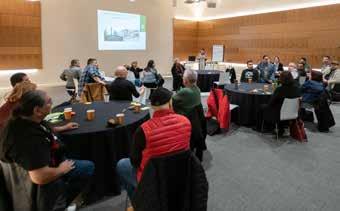
3 minute read
Including
Janet MacDonald, head of Learning, at the future site of Royal BC Museum’s new Collections and Research Building.
A Community Engagement Roadmap for the Future
INCLUDING
Janet MacDonald
Head of Learning On September 21, 2020, I stood on a bluff overlooking the future site of our new Collections and Research Building (CRB). It was a ground-zero moment for me in the heart of the Royal Bay community. Surrounded by our closest neighbours, I began to think of all the learners who might come to us here–waves of potential collaborators radiating in and out from this spot in concentric circles of community.
Community engagement is not new to the museum and archives. So many collaborations have resulted in successful initiatives for the benefit of many. You need only reference these editions of What’s inSight to see the myriad accomplishments. But what we are undertaking now is unprecedented and on a grand scale. Within this new environment, communities will lead in sharing their heritage and their knowledge, working with the museum and archives to increase public understanding of how their histories and values have shaped provincial life. This change requires us to let go of some of the traditional ways of development, and to hope that citizens can and will engage in this new vision. How might we tap into their diverse needs and aspirations for this state-of-the-art facility?

Over 200 members of the Punjabi-Canadian community gathered in the Becoming BC gallery to reimagine the museum’s logging display and submit their ideas for future inclusion. The information gathered resulted in the installation of a new permanent display, November 21, 2015. The first in a series of ongoing consultations that continues to inform the present and future Indigenous Artist Program at the Royal BC Museum, January 19, 2019.

We have a plan
Over the past six months, we have put our collective heads together and devised a community engagement road map–defining a high-level framework that encapsulates our strategic aims and our rationale for the importance of involving the community. It is important for us to challenge the assumptions and inherent biases of the CRB project, and we are working with the Royal BC Museum’s equity, diversity and inclusion consultant on key areas that might be barriers to inclusion. We are dedicated to working with underserved audiences and identifying opportunities to engage and provide service to these groups. A top priority is placed on Indigenous input and co-creation—we are specifically working with the Indigenous communities of Songhees and Esquimalt and the adjacent Scia’new (Beecher Bay) and T’Sou-ke nations. Internal questions have been carefully considered with regards to our audiences.
Who could be affected (positively or negatively) by our plans? This is an integral aspect of ensuring inclusivity, requiring us to consider implications of background, gender, ethnicity, religion, sexual orientation, race, age, language, socio-economic status, development differences, education and geography.
They all play a role.
Do we want to reach as many people as possible, or are we concentrating on specific groups or geographical areas?
There are no definitive answers, but we have begun with a focused approach that can expand over time.
We will use different approaches to engagement as appropriate, including focus groups, steering groups, public meetings, events, seminars, audits, media campaigns, web-based surveys and a website. We are committed to transparency, with open and continual communication. We know that keeping everyone in the loop and feeding back engagement results on a regular basis will help the development of trust-based relationships. The decisionmaking processes will give power to communities to make choices about the CRB policies and programs that impact them. This, we hope, will keep relationships strong and increase participation and engagement in all future consultations. We will then be set to initiate actionable strategies and start implementing programs and collaborations when we open to the public in 2024–25. Planning four years out is none too soon!
Consultations will begin this year, and we are looking forward to meeting many networks of community members in the first phase. Please visit rbcm.ca for the most up-to-date information.










